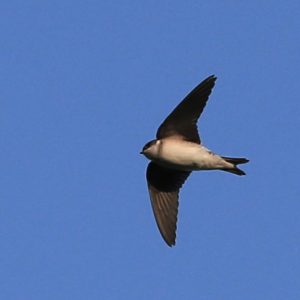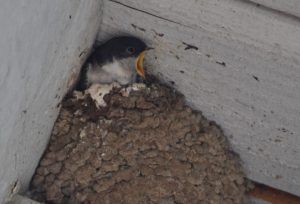 House martins usually arrive back in the UK sometime in April, occasionally at the end of March.
House martins usually arrive back in the UK sometime in April, occasionally at the end of March.- House martins spend the winter months in Africa, though we still don’t know exactly where our UK birds go.
- It used to be thought that house martins and swallows hibernated during the winter in the mud at the bottom of ponds.
- A house martin nest is made up of around 1000 lumps of clay and weighs about 500g. It is most often lined with white feathers brought in by the male bird.
- On average it takes about three weeks for a house martin to construct a nest.
- House martins generally prefer to reuse old nests than to start a new one from scratch. And they nest communally so houses with house martins usually have a number of nests.
- House martins mate inside their nests but they are not terribly faithful to their partners – three-quarters of nests contain chicks fathered by another male.
 When they have a nest, house martins sleep in it, but it’s still not known whether they sleep on the wing for the rest of the year.
When they have a nest, house martins sleep in it, but it’s still not known whether they sleep on the wing for the rest of the year.- Up to 11 house martins have been found to sleep in a single nest – both adult birds and their first and second brood of young. Now that’s cosy…
- Their diet consists almost entirely of small flying insects and spiders, the plankton of the air. If you hate mosquitoes, love house martins.
- The female lays four or five eggs that take two to three weeks to hatch. The chicks then spend up to five weeks in the nest before they are ready to take to the wing.
 House martins start to leave us in August but they can still be seen as late as October, especially if they have raised a second or third brood.
House martins start to leave us in August but they can still be seen as late as October, especially if they have raised a second or third brood.- Look out for house martins in late summer congregating on house roofs or whirling about meadows in large numbers ready for the long migration.
- House martins face a number of threats, some natural but most man-made. Their nests are sometime predated by other birds, they are hunted by hobbies, a fast, migratory bird of prey. But the biggest threats come from us – some people still knock the nests off their houses though it’s illegal. And agricultural changes have reduced the number of insects so there’s less food for the birds.
 Much of the information about house martins comes from a wonderful new book called Guests of Summer – A House Martin Love Story by Theunis Piersma, available from the BTO website, price £12.30. Recommended.
Much of the information about house martins comes from a wonderful new book called Guests of Summer – A House Martin Love Story by Theunis Piersma, available from the BTO website, price £12.30. Recommended.